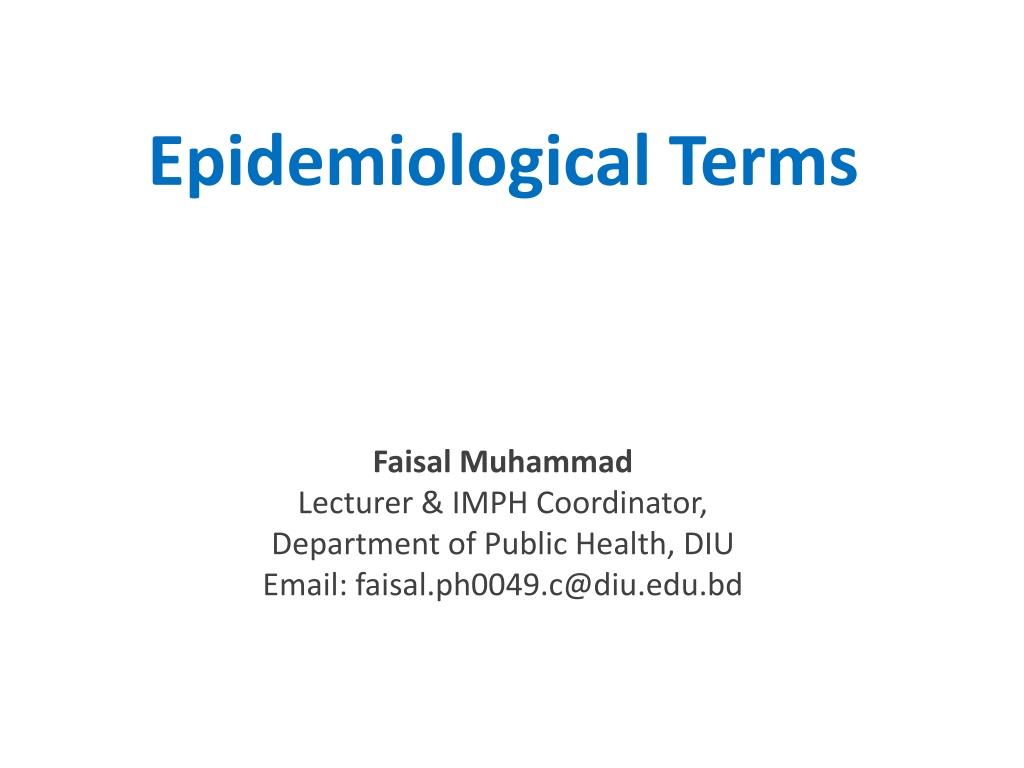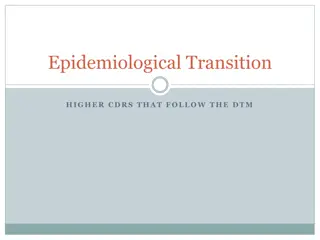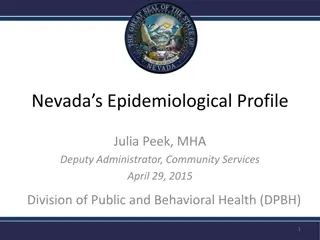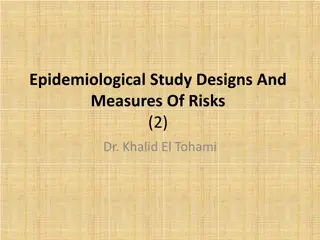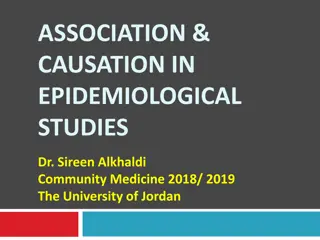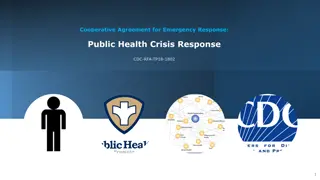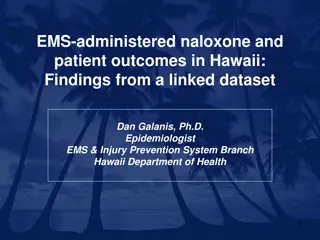Understanding Epidemiological Terms in Public Health
Epidemiological terms such as infection, infestation, infectivity, infectiousness, and more are important in understanding the spread and control of diseases. This detailed guide by Faisal Muhammad covers key concepts in public health, including definitions, examples, and the importance of terms like incubation period. Explore this comprehensive resource to enhance your knowledge of epidemiology.
Download Presentation

Please find below an Image/Link to download the presentation.
The content on the website is provided AS IS for your information and personal use only. It may not be sold, licensed, or shared on other websites without obtaining consent from the author. Download presentation by click this link. If you encounter any issues during the download, it is possible that the publisher has removed the file from their server.
E N D
Presentation Transcript
Epidemiological Terms Faisal Muhammad Lecturer & IMPH Coordinator, Department of Public Health, DIU Email: faisal.ph0049.c@diu.edu.bd
Learning Objectives: Infection, Infestation, Infectivity, Infectiousness Infectious disease Incubation period Latent period Generation time Communicable disease, Communicable period Carrier, Reservoir, Case: Suspected, Probable, Confirmed, Epi-curve Source of infection Epidemic, Endemic, Pandemic, Eradication Segregation, Quarantine, Isolation
Infection: The process of entry and development or multiplication of an infections agent in the body of man or animal. An infection does not always cause a disease. Infestation: The present of living infections agent on exterior surface of the body (lodging developing and reproduction of parasite. Gastrointestinal tract is as exterior surface for infestation of intestinal parasite e.g. Worm infestation).
Infection (Of microorganism) Head lice infestation
Infectivity The ability of an infectious agent to invade and multiply (to produce successful infection) in the host. The characteristics of the disease agent that embodies capability to enter, survive and multiply in the host. A measure of infectivity is secondary attack rate. The proportion of exposure, in defined circumstance, that result in infection. Infectiousness A characteristic of an infections disease that concerns relative ease with which it is transmitted to other hosts. The infectiousness depends on- Mode of transmission Portal of exit and portal of entry Agent characteristics of ability to survive away from host. Infectivity
Infectious disease: A clinically manifest disease of man or animal resulting from an infection. A communicable disease which can very easily and very rapidly attack a susceptible host from a primary of index ease e.g. measles. Infective Dose: Infective does of an agent is the amount required to cause infection susceptible host. E.G., Cholera-10 to 10 organisms. Incubation period (Intrinsic incubation period): The time period between the entrance of pathogenic organism into a host and the appearance of the first symptom of the specific disease. Extrinsic Incubation period: In a vector (biological vector), the period between entry of the infectious agent into the vector and the time at which the vector become infective i.e., readily transmission of infectious agent from the vector to a fresh host is possible. E.g., Malaria, Filariasis, Dengue etc.
Importance of incubation period in epidemiology: 1. Helpful in tracing the source of infection and contacts 2. Useful in determining the period of surveillance or quarantine 3. Helps to know the preventive way by immunization 4. Helps to identifying point source or propagated epidemics 5. Useful in estimating the prognosis of a disease.
Latent period: The period following exposure, when pathogenic changes are not apparent, and ending with onset of symptoms of a chronic disease. In non-infectious disease, the period from disease initiation to disease detection. Generation time: Time period when the host is capable of transmitting the disease to susceptible individual before the development of clinical feature of the disease in the host. It is the time of maximum infectivity of the host.
Difference between incubation period and generation time In general generation time is roughly equal to the incubation period. However, these two terms are not the same. The time of maximum communicability may precede or follow the incubation period. For example, communicability appears to reach its height about 48 hours before the onset of swelling of the salivary glands. in mumps,
Communicable disease A disease which can get transmitted from one host or reservoir to another through transference of a sufficient quantity of the causative agents is called communicable disease, e.g. is malaria, enteric fever, tuberculosis etc. An illness due to specific infectious agent or its toxic products capable being directly or indirectly transmitted from man to man, animal to animal, from the environment (through air, dust, soil water, food etc.) to man or animal. Communicable period The time or times during which an infectious agent may be transferred directly or indirectly from an infected person to another person, from an infected animal to man, or from an infected person to an animal, including arthropods. Period of time during which infectious agents are able to spread infection from a host to a susceptible individual.
Carrier: A person or animal that harbours a specific agent in the absence of discernable clinical disease and serves as a potential source of infection. A person (apparently healthy person) harbouring the infecting organism without clinical manifestation which can transfer the organisms (mechanical biological involvement).
Carrier cont..... A carrier may be asymptomatic (never show signs of the disease) or may show signs of the disease only in the incubation period, convalescence, or post convalescence. Carrier Cases Cure Healthy carrier Reservoir Convale scent Subclinical Incubatory
Carrier con.... Classification of carrier: Healthy carrier- the carrier state may occur in an individual with an infection that is in appearance though its course e.g., Typhoid Mary, hepatitis B, cholera , poliomyelitis. Incubatory carrier- the carrier state may occur during incubation period e.g., measles, mumps, influenza etc. Convalescent carrier- The carrier state may occur in some period continuing after recovery e.g. Typhoid, bacillary or amoebic dysentery, diphtheria etc. Temporary or transient carrier- incubatory or convalescent carrier. Chronic carrier- healthy carrier
Element of a carrier state The presence in the body of the disease agent. The absence of recognizable symptoms and signs of disease. The shading of the disease agent in the discharges or excretions, thus acting as a source of infection for other persons. Epidemiological Importance of carrier Carrier are less infectious but are more dangerous than cases, because they escape recognition and continuing as they do to live normal life among the population or community, they readily infect the susceptible individuals over a wider areas and longer period of time under favourable conditions.
Difference between carrier and subclinical infection In carrier, a person is harbouring the infectious organisms without clinical manifestation after development of immunity- antibody formation. In subclinical infection, a person is infected by the infectious organism without apparent (recognized) clinical development of immunity-antibody formation. manifestation before
Source and Reservoir of infection Reservoir of infection: Usual (not under modified condition) natural places of growth or multiplication of an infectious agents. Any person, animal, arthropod, plant, soil, water or substance, or combination of these, in which an infectious agent normally lives and multiplies primarily for survival and where it reproduces itself in such a manner that can be transmitted to a susceptible host. Human animal and environment can serve as reservoirs. 3 types of reservoirs Human (Homologous is applied when another member of the same species is the victim)- may be a case or carrier. This constitutes 95% to 98%. Animal (Heterogonous is applied when the infection is derived from a reservoir other than man)- these may be case or carrier of diseases e.g., dogs in rabies. This constitutes>1.5%. Non-living things- soil, water, food etc. very rarely plant act as reservoir e.g., poisonous mushrooms
Source of infection Source of infection: The person, animal, object or substance from which an infectious agent passes to the host. Reservoir and source of infection Examples of reservoir and source of infection: 1. In hookworm infection, the reservoir is man and the source of infection is the soil, contaminated with infected larve. In typhoid fever, the reservoir may be a case or carrier, and source of infection may be faces, or urine of patients or contaminated food, milk or water. In tetanus, the source and reservoir are the same, that is soil. 2. 3. The terms reservoir and source are not always synonymous. The term source refers to the immediate source of infection and may or may not be a part reservoir.
Case Case: In epidemiology, case is defined as a person in the population or study group identified as having the particular disease, health disorder or condition under investigation.
Case definition Chikungunya Disease WHO Case Definition Clinical case definition: A suspected case involves a patient presenting with acute onset of fever, usually with chills/rigors, that lasts for 3-5 days with pain in multiple joints/swelling of extremities that may continue for weeks to months. Laboratory criteria for diagnosis: Detected positive of chikungunya virus (CHIKV) or viral RNA in the laboratory tested in serum collected <6 days after onset of illness. Case classification: Suspected: A case that meets the clinical case definition. Probable: Should have epidemiological link to a confirmed case-- residing or having visited epidemic areas, having reported transmission within 15 days prior to the onset of symptoms . Confirmed: A suspected or probable case with laboratory confirmation.
Case cont... Primary case: 1. The individual who introduces the disease into the family or group under study. 2. The first case of a communicable disease introduced into the population unit being studied. Index case: The first case of a disease in a family or other defined group to come to the attention of the investigator. It is not always the primary case. Secondary case: The case that develops from contact with primary case. Serial interval: The gap in time between the onset of the primary case and the secondary case.
Epidemic: 1. Unusual occurrence of a disease in the light of past experience essentially affected with common exposures . The occurrence, in a community or region, of cases of an illness, specific health behaviour, or health related events, clearly, clearly in excess of normal expectancy. (syn:outbreak ) An epidemic is the occurrence in a community or region of a number of cases of a disease that is unusually large or unexpected for given place and time. 2. 3. 2 types of epidemic: 1. Point Source Epidemic: In a point source epidemic, susceptible individuals are exposed more or less simultaneously to one source of infection. This results in a very rapid increased in the number of cases, often in a few hours. The duration of occurrences of an epidemic is only in a longest period of its incubation period e.g., food-poisoning. 2. Propagated Source if Epidemic: In a propagated or contagious epidemic, the disease is passed from person to person and the initial rise in the number of cases is slower. An example is the measles outbreak.
Endemic Endemic: 1. An endemic disease is one that is usually present in a given geographical area or population group at relatively high prevalence and incidence rates, in comparison with other areas or populations e,g., malaria. 2. The constant presence of a disease or infectious agent within a given geographical area or population group, without importation from outside, either throughout the year or in a particular season or yearly basis. If conditions change either in the host or environment disease may become epidemic. Two types of endemic: 1. Hyperendemic: A disease that is constantly present at a high incidence and/or prevalence rate and affect all age group equally e.g., malaria, leprosy. 2. Holoendemic: A disease for which a high prevalence level of infection begins early in life and affects
Epi Curve To show the time course of a disease outbreak or epidemic, we use a specialized graph called an epidemic curve. For very acute diseases with short incubation periods (i.e., time period between exposure and onset of symptoms is short), we may show time as the hour of onset. For diseases with longer incubation periods, we might show time in 1-day, 2-day, 3-day, 1-week, or other appropriate intervals. By convention, we use this format, called a histogram, for epidemic curves. In common source epidemics, the main feature of epidemic curve is- The epidemic curve rises and falls abruptly within a short period following exposure usually as a single spike (Holomiantic curve). In propagated epidemics, the main feature of epidemic curve is- The epidemic curve shows slow rises, long duration and slow fall (Prosodemic curve). 23
Epidemic Curve A graphic plotting of the distribution of cases by time of onset. The epidemic curve may suggest: 1. A time relationship with exposure to a suspected source. A cyclical or seasonal pattern suggestive of a particular infection, and common source or propagated spread of the disease. 2.
Pandemic (Global disease) A disease is pandemic when an epidemic usually affecting a large proportion of the population and occurring over a very wide geographical area such as a section of a nation, the entire nation, a continent or the world e.g. HIV/AIDS, Avian influenza etc. Sporadic: A disease is sporadic when the cases haphazardly from time infrequently. The in space and time that they show little or no connection with each other, nor a recognizable common source of infection, e.g., tetanus, poliomyelitis etc. A sporadic disease may be the starting point of an epidemic when conditions are favourable for spread. occur irregularly , and generally to time cases are so few and separated widely its
Zoonosis Zoonosis: An infection or infectious disease transmissible under conditions from animals to man. May be enzootic or epizootic- e.g., rabies, plague, tuberculosis, anthrax etc. natural bovine
Movement of disease Pattern No. Of persons involved Period for which mass disease lasts Territorial extent of disease outbreak Sporadic Small Short Scattered Endemic High-Large (within average fluctuation) Long (continuous) Localized Epidemic Unusual Number Short (usually comm.disease ) or Long (usually NCDs) Localized regional, or extensive Pandemic Large Short Spreads from one country to another in a short time Spreads from one country in a short time.
Nosocomial infection origination denotes a new condition) associated with include infection of surgical wounds, hepatitis B tract infections. Nosocomial (hospital acquired) in a patient while in a hospital or health care facility. It disorder (unrelated to the patient's being infection is an infection primary in a hospital. Examples and Urinary Opportunistic infection provided by a defect in hence cause disease. The organisms simplex. Cytomegalovirus Toxoplasma, example, opportunistic infections are Infection by an organism that is not normally pathogenic, but cause disease if resistance is This is infection by an organism (s) takes the host defence to infect the host and the opportunity include Herpes etc. M, tuberculises very common in AIDS. For can lowered (if it is susceptible host).
Iotrogenic (physician-induced) disease Any unpowered or adverse consequence of a preventive, diagnostic therapeutic procedure, that causes disability or death resulting from a physician s professional activity or from the professional activity of other health professionals. The disease may be serious enough to prong the hospital stay, require special treatment or actually threaten life. Most of the episodes are related to drug therapy, immunization or diagnostic reactions to penicillin and immunizing agents. Aplastic anaemia following choromhenical., childhood parental x-ray, hepatitis B following blood transfusion. regimen handicap, or impairment, procedures e.g., the use due of to leukaemia
Eradication Termination of all transmission of infection by extermination of the infections agent through containment. surveillance and Eradication is an absolute process, an all or none phenomenon, restricted to termination of an infection from the whole world. It implies that the disease will no longer occur in a population. To-date, only one disease has been eradicated, that is small pox. However, if a particular disease is rooted out from a country is called elimination. The term elimination is sometimes of disease (e .g., measles) from a large geographic region or political jurisdiction. In the state of our present knowledge, disease which are amenable to eradication are poliomyelitis measles, diphtheria and guinea worm. used to describe eradication
Isolation Complete separation, for the period of communicability of infected person or animals from others in such places and under such condition as to prevent or limit the direct or indirect transmission of the infectious agent from those infected to those who are susceptible or who may spread the agent to others. Usually the highly infectious diseases are brought under separation e.g., chicken pox measles, diphtheria, vital conjunctivitis etc. Quarantine activities) of who is suspected to come in contact with any disease (exposed to a case of communicable disease) within the period of communicability, to prevent disease transmission during the period. This is usually done by health authority in airport, sea port, land port. Quarantine is detention (restriction of movements apparently healthy persons or and animals, incubation
Segregation Detention (restriction of movements and activities) for a while of apparently healthy persons or animals based on the suspecting/ unconfirmed clinical sign/ symptoms. The segregation is often performed non-clinical persons or field level health workers within the period of communicability, to prevent disease transmission during the incubation period. This is usually done by health authority in airport, sea port, land port.
